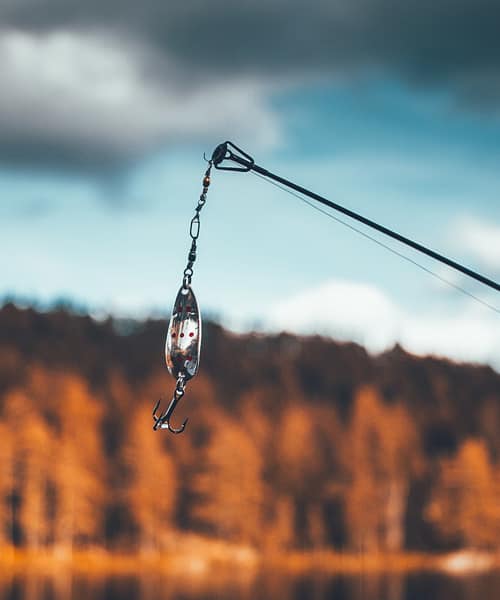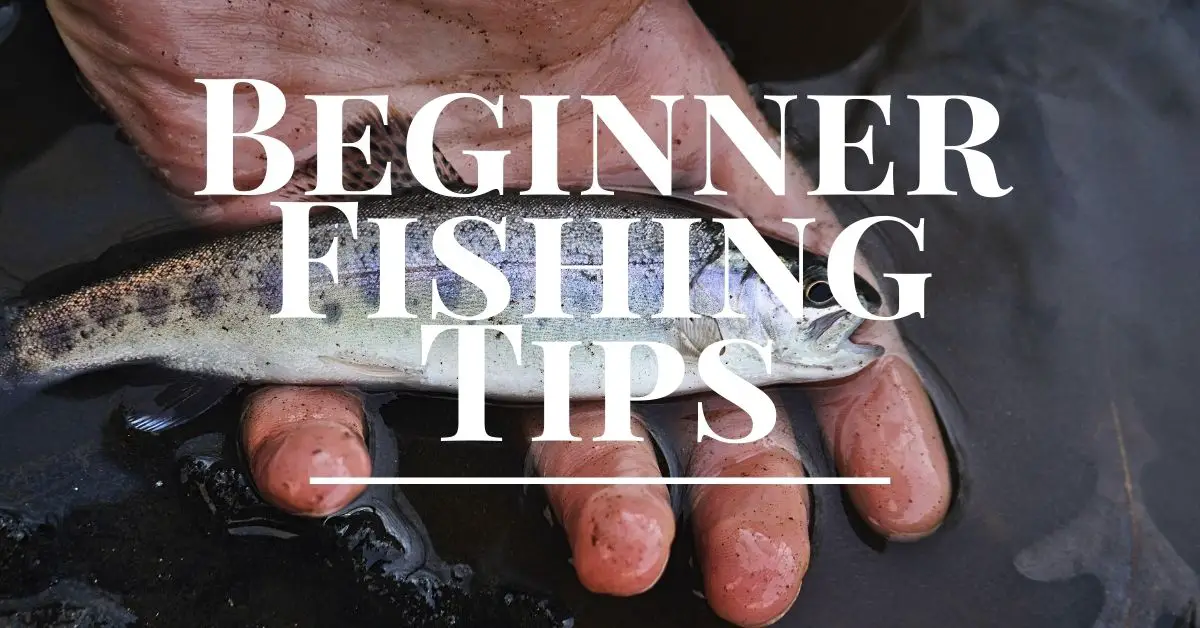Learning to fish takes practice. One of the most enjoyable things about fishing is that there is an endless amount of skills and techniques to learn.
Even advanced anglers are constantly learning new things.
If you’re a beginner, fishing can seem overwhelming at first. But we’re here to help.
We created this 101 guide of basic fishing tips to point you in the right direction and get you started on your fishing journey.
By the end of this resource, you will have learned the basics of fishing, and you will be ready to get out on the water and catch fish.
Table of Contents
Fishing Technique
How to Cast a Fishing Rod
Casting a fishing rod is one of the most fundamental skills you will need to develop to be a successful angler.
It will take a bit of practice to master, but if you try consistently you should be able to get it down pretty quickly.
There are two common types of fishing rods and reels that you will use: spinning rods or baitcasting rods. Each of these is cast a different way.
How to Cast Spinning Reels
Spinning reels are best for beginners because they are much easier to use and they tend to be pretty budget-friendly.
If you are completely new to fishing, we highly recommend using a spinning rod and reel over baitcasting gear.
The steps for casting a spinning reel are pretty simple. Here’s what you need to do:
- Grab the rod and hold it naturally between your fingers. Hold it near your side at around mid waist level. The reel should be below the rod.
- Line up the bail, grab the line with your index finger, and open up the bail.
- Let around 10 – 18 inches of line out so your lure is hanging.
- Raise your rod overhead and bring it forward quickly pointing it at the spot you want your lure to land.
- Release the pressure with your index finger and let your lure pull the line out.
- Close the bail with your hand and get ready to start reeling in to work your lure.
How to Cast Baitcasting Reels
Baitcasting rods and reels are a little more advanced than spinning reels. They can be more difficult for beginners to get used to, but they are a must have when you’re targeting heavier fish or need to cast with a high degree of accuracy.
Here’s are the steps for casting with baitcasting reels:
- Grab the rod and hold it naturally between your fingers. The reel should be on top of the rod with your thumb on the line.
- Aim at your target while keeping the rod tip just above eye level.
- Push the button to free spool while holding your thumb against the line.
- Bring the rod in a sweeping motion over your shoulder and quickly bring it forward while pointing your rod tip at the target.
- As the rod is going forward, lift your thumb off the spool so the line can shoot off the reel.
- When the lure hits the water, place your thumb back on the spool.
The keys to casting are to aim your rod at the target and make the cast in one fluid motion. When you’re new it will help to break it down into steps. But after you feel comfortable with steps, practice on making the cast in one fluid motion.
Learn How to Work Your Lures
Every lure is going to be a little bit different to get swimming properly.
The goal is to make your lure mimic how real bait moves naturally through the water to entice fish to bite.
This is usually done through a combination of retrieval speed and twitching your rod tip.
Experiment With Different Tactics
Sometimes changing things up is the best way to get more bites.
Experiment with different lures, different colors, and fishing at different depths.
Try working your lure slowly, or try working it faster to see what works best in the waters you are fishing.
Varying your tactics can improve your odds of landing a fish when they aren’t responding to you.
Don’t Reel to the Tip
One of the biggest mistakes beginners make is they reel their fish all the way to the tip of the rod when fishing a fish. Don’t do this.
You want to leave about a rods length of line on the fish when you land it.

Learn to Set Your Hook
Generally, you want to wait until you feel the full weight of the fish before setting your hook.
Wait until you really feel the fish tugging away at your line. Then, reel in any slack to keep your line tight so you will be in a better situation for setting your hook. Forcefully and quickly lift the rod tip to set your hook.
This is a general guideline for setting your hook. After enough practicing you will get a good idea of the amount of force and timing that you need for a proper hook set.
Where To Fish
Fish the Weeds
A lot of fish like to remain in the cover of weed beds before coming out to attack their food. Fishing near the weeds can be very productive.
Furthermore, aquatic vegetation tends to attract insects, and insects attract baitfish, baitfish attract bigger fish. That is why you will definitely want to fish the weeds.
Fish Structure
Fish also tend to hang near structure that protects them from predators and helps them ambush other fish. Good places to fish include branches, submerged trees or logs, rocks, and boat docks.
Learn the Area
You are going to want to learn the area so you can understand where the aquatic vegetation is, where cover and structure is, and learn the different depths of the place you are fishing.
If you can get your hands on a topographical map—even better. Once you understand where the fish are likely to be, your odds of catching one will greatly increase.
Inlets and Outlets
Inlets and outlets where water enters or drains from a lake often provide a nutrient-rich environment that attracts baitfish. Wherever there is baitfish, the large fish are likely to follow.
Fishing Equipment
Use The Right Gear
One of the hardest parts of fishing for beginners is understanding all the different gear options and when to use them.
If you’re completely new to fishing, it may be best to ask an angler friend what you will need in terms of rod action, fishing line, and hook size.
For beginners though a basic spinning rod with monofilament line setup will do for most situations.
Learn Your Fishing Knots
There is a wide variety of fishing knots that are best for different fishing situations.
It’s important to try and learn how to tie these knots and when to use them. The first knot you should learn is the palomar knot. Learn more about fishing knots here.
Match the Hatch
This phrase is widely used in the fishing world—but for good reason. It works.
What this means is that you want to match your bait or lure to whatever the fish are already eating in the waters you are fishing.
Using a bait that resembles what they are already eating is often the best way to get the fish to bite.
Safety is Important
Don’t dismiss bringing proper safety equipment on your fishing trip. Often overlooked, but important gear can include: sunscreen, rain gear, PFDs, first aid kit, hydration, and nutrition).
Important Tips
Stay Patient
Don’t get discouraged if the fish aren’t biting. Fishing is a game of patience. A good angler will experiment with a variety of lures and techniques to see what will get the fish biting.
Finding the fish isn’t always easy, and neither is getting them to bite. Stay calm and prepare to methodically change where you are fishing and your techniques throughout the day to see what works.
Keep Quiet
Some fish can be easily spooked, so you don’t want to make too much noise when approaching them. Try to land your lures gently in the water.
Better yet, cast them past the strike zone and reel them into the hot spot to avoid spooking fish. If you’re lure lands directly on top of the fish they may get spooked and swim away.
Have Your Fishing License
Make sure that you have the appropriate fishing license and/or stamps. Nobody wants to get in trouble and deal with the stress when the day was supposed to be about relaxing and having fun.
Learn about the Fish
Having a little knowledge about the fish you are targeting can make all the difference when fishing. Check out our resources on how to catch these popular game fish:
Summary
If you’re new to fishing, all of the different things you need to learn can seem overwhelming at first. But try not to get too overwhelmed and understand that even experienced anglers are learning new things all the time. Fishing is a hobby where you never really stop learning. So just take things one step at a time and you will be on your way to catching fish in no time.
The key things to learn are:
- Proper fishing technique
- Where to catch the fish
- What fishing gear to use
